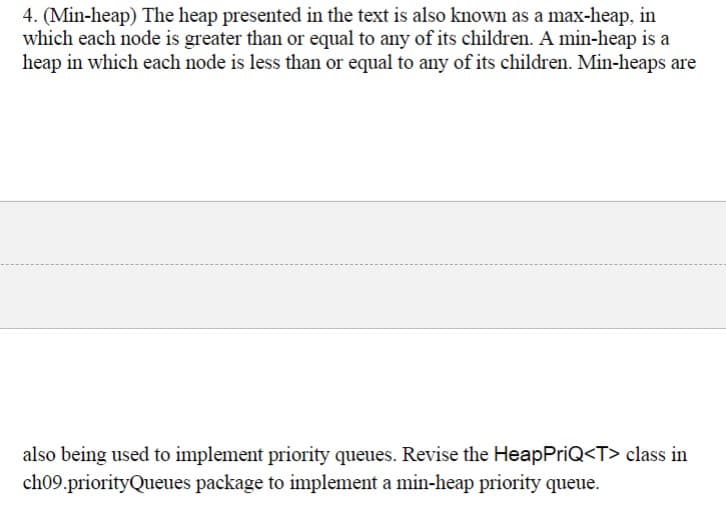4. (Min-heap) The heap presented in the text is also known as a max-heap, in which each node is greater than or equal to any of its children. A min-heap is a heap in which each node is less than or equal to any of its children. Min-heaps are also being used to implement priority queues. Revise the HeapPriQ class in ch09.priorityQueues package to implement a min-heap priority queue.
public class HeapPriQ<T> implements PriQueueInterface<T>
{
protected ArrayList<T> elements; // priority queue elements
protected int lastIndex; // index of last element in priority queue
protected int maxIndex; // index of last position in ArrayList
protected Comparator<T> comp;
public HeapPriQ(int maxSize)
// Precondition: T implements Comparable
{
elements = new ArrayList<T>(maxSize);
lastIndex = -1;
maxIndex = maxSize - 1;
comp = new Comparator<T>()
{
public int compare(T element1, T element2)
{
return ((Comparable)element1).compareTo(element2);
}
};
}
public HeapPriQ(int maxSize, Comparator<T> comp)
// Precondition: T implements Comparable
{
elements = new ArrayList<T>(maxSize);
lastIndex = -1;
maxIndex = maxSize - 1;
this.comp = comp;
}
public boolean isEmpty()
// Returns true if this priority queue is empty; otherwise, returns false.
{
return (lastIndex == -1);
}
public boolean isFull()
// Returns true if this priority queue is full; otherwise, returns false.
{
return (lastIndex == maxIndex);
}
public int size()
// Returns the number of elements on this priority queue.
{
return lastIndex + 1;
}
private void reheapUp(T element)
// Current lastIndex position is empty.
// Inserts element into the tree and ensures shape and order properties.
{
int hole = lastIndex;
while ((hole > 0) // hole is not root and element > hole's parent
&&
(comp.compare(element, elements.get((hole - 1) / 2)) > 0))
{
// move hole's parent down and then move hole up
elements.set(hole,elements.get((hole - 1) / 2));
hole = (hole - 1) / 2;
}
elements.set(hole, element); // place element into final hole
}
public void enqueue(T element) throws PriQOverflowException
// Throws PriQOverflowException if this priority queue is full;
// otherwise, adds element to this priority queue.
{
if (lastIndex == maxIndex)
throw new PriQOverflowException("Priority queue is full");
else
{
lastIndex++;
elements.add(lastIndex,element);
reheapUp(element);
}
}
private int newHole(int hole, T element)
// If either child of hole is larger than element, return the index
// of the larger child; otherwise, return the index of hole.
{
int left = (hole * 2) + 1;
int right = (hole * 2) + 2;
if (left > lastIndex)
// hole has no children
return hole;
else
if (left == lastIndex)
// hole has left child only
if (comp.compare(element, elements.get(left)) < 0)
// element < left child
return left;
else
// element >= left child
return hole;
else
// hole has two children
if (comp.compare(elements.get(left), elements.get(right)) < 0)
// left child < right child
if (comp.compare(elements.get(right), element) <= 0)
// right child <= element
return hole;
else
// element < right child
return right;
else
// left child >= right child
if (comp.compare(elements.get(left), element) <= 0)
// left child <= element
return hole;
else
// element < left child
return left;
}
private void reheapDown(T element)
// Current root position is "empty";
// Inserts element into the tree and ensures shape and order properties.
{
int hole = 0; // current index of hole
int next; // next index where hole should move to
next = newHole(hole, element); // find next hole
while (next != hole)
{
elements.set(hole,elements.get(next)); // move element up
hole = next; // move hole down
next = newHole(hole, element); // find next hole
}
elements.set(hole, element); // fill in the final hole
}
public T dequeue() throws PriQUnderflowException
// Throws PriQUnderflowException if this priority queue is empty;
// otherwise, removes element with highest priority from this
// priority queue and returns it.
{
T hold; // element to be dequeued and returned
T toMove; // element to move down heap
if (lastIndex == -1)
throw new PriQUnderflowException("Priority queue is empty");
else
{
hold = elements.get(0);
toMove = elements.remove(lastIndex);
lastIndex--;
if (lastIndex != -1) // if priority queue is not empty
reheapDown(toMove); // restore heap properties
return hold; // return largest element
}
}
@Override
public String toString()
// Returns a string of all the heap elements.
{
String theHeap = new String("the heap is:\n");
for (int index = 0; index <= lastIndex; index++)
theHeap = theHeap + index + ". " + elements.get(index) + "\n";
return theHeap;
}
}

Trending now
This is a popular solution!
Step by step
Solved in 2 steps


